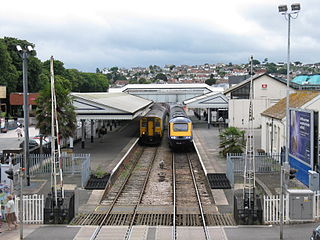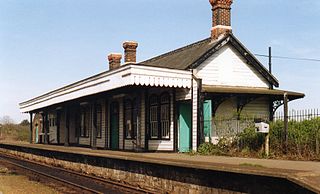
Exmouth railway station serves the town of Exmouth in Devon, England and is 11.25 miles (18 km) south of Exeter St Davids, the terminus of the Avocet Line. The station is managed by Great Western Railway, who operate all trains serving it.

Salisbury railway station serves the city of Salisbury in Wiltshire, England. It is 83 miles 43 chains (134.4 km) from London Waterloo on the West of England line to Exeter St Davids. This is crossed by the Wessex Main Line from Bristol Temple Meads to Southampton Central. The station is operated and served by South Western Railway (SWR), and is also served by Great Western Railway (GWR).

Meols Cop railway station serves the Blowick suburb of the coastal town of Southport, Merseyside, England. The station has an island platform and is served by Northern Trains‘ Manchester Victoria/Manchester Piccadilly - Southport via Wigan Wallgate branch services, on which it is the last stop before the terminus.

Bidston railway station is a railway station that serves the village of Bidston, Merseyside, England. The station is situated at the junction of the West Kirby branch of the Wirral line, which is part of the Merseyrail network, and serves as the northern terminal for the Borderlands line from Wrexham Central, operated by Transport for Wales.

Ilkley railway station serves Ilkley in the City of Bradford, West Yorkshire, England. On the Wharfedale Line, it is served by Class 333 electric trains run by Northern Trains, which also manages the station.

Paignton railway station serves the town and seaside resort of Paignton in Devon, England. It is 222 miles 12 chains (358 km) from London Paddington. It opened in 1859 and is now the terminus of Riviera Line services from Exeter and heritage services on the Dartmouth Steam Railway from Kingswear.

The Garstang and Knot-End Railway [sic] was a railway line, between Garstang and Pilling, across the Fylde of Lancashire, England. It was built by local agricultural interests to develop unproductive land. It had been intended to continue to Knott End but ran out of money. It eventually opened in 1870. In 1898 the Knott End Railway (KER) was authorised to continue to Knott End; it opened in 1908. The two companies were associated and the KER acquired the earlier company. The KER was still desperately short of money, and local people who were owed money bought rolling stock to keep the company going.

Pilling railway station served the villages of Pilling and Stake Pool in Lancashire, England.
Cockerham Cross railway station, also known as Cockerham Crossing railway station was a halt at a level crossing on a road that crossed Cockerham Moss towards Cockerham in Lancashire, England. It opened with the line in 1870 and closed in 1930.

Ingrow (West) railway station is a single-platform station serving the suburb of Ingrow in Keighley, West Yorkshire, England. It is served by the preserved Keighley and Worth Valley Railway. The station is 1.25 miles (2 km) west of Keighley station and 2.25 miles (3.62 km) west of Haworth railway station.

Barnoldswick railway station was the only railway station on the Midland Railway's 1-mile-64-chain (2.9 km) long Barnoldswick Branch in the West Riding of Yorkshire in England. It served the market town of Barnoldswick, which was in West Riding of Yorkshire at the time. The line left the Leeds and Bradford Extension Railway at Barnoldswick Junction 55 chains from Earby railway station. The line through the junction was on a 20-chain radius after which it converged to a single track and ran in a straight but undulating line to Barnoldswick. The passenger train that ran back and forth between Barnoldswick and Earby was known locally as the 'Barlick Spud' or 'Spudroaster'. The real reason for the name is lost in time, but the two versions that were commonly recited are that the original branch locomotive was so small it looked like a portable potato roaster used by a local vendor or that the journey time was the same as that taken to roast a potato in the locomotive's firebox.

There are eleven disused railway stations on the Exeter to Plymouth line between Exeter St Davids and Plymouth Millbay in Devon, England. At eight of these there are visible remains.

Felixstowe Beach is a disused railway station which served the seafront and southern part of Felixstowe in Suffolk, England. First opened in 1877, the station closed to freight on 5 December 1966 and to passenger traffic on 11 September 1967. The line remains open and sidings to the south of the station connect with railway lines in the Port of Felixstowe.
The Winsford and Over branch line was a railway line serving the town of Winsford in Cheshire. It was operated by the Cheshire Lines Committee (CLC) from 1870 until the railways were nationalised under the Transport Act 1947, which took effect on 1 January 1948. Thereafter the branch was operated by British Railways London Midland Region until the line's closure in 1967.

Bourne was a railway station serving the town of Bourne in Lincolnshire, which opened in 1860 and closed to passengers in 1959.

Hawick railway station served the town of Hawick, Scottish Borders, Scotland from 1849 to 1969 on the Waverley Route.

Whittingham railway station served the village of Whittingham, Northumberland, England from 1887 to 1953 on the Cornhill Branch.

Tow Law railway station served the town of Tow Law, County Durham, England, from 1847 to 1965 on the Stanhope and Tyne Railway.
Cogie Hill railway station, also known as Cogie Hill Halt railway station and Cogie Hill Crossing railway station served the village of Winmarleigh, Lancashire, England, from 1870 to 1930 on the Garstang and Knot-End Railway.

Hemyock railway station served the village of Hemyock, Devon, England, from 1876 to 1963 on the Culm Valley Light Railway.

















